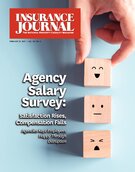In a year marred by a pandemic, massive Western U.S. wildfires, civil unrest, and a contentious election, California’s surplus lines market “didn’t miss a beat.”
That was the message from Ben McKay, CEO and executive director of the Surplus Line Association of California, who said surplus lines premiums in 2020 in California grew 22.7%, while the surplus lines item count grew 8%, despite the pandemic that gripped the world.
The disparity in premium and item growth points to a potential hardening market, McKay added.
He was speaking during the group’s annual meeting held virtually in early February.
Other speakers included: SLA-Cal Chair Terri Moran, chief underwriting officer of Paul Hanson Partners – Specialty Insurance Solutions; Robert Hartwig, with the Risk and Uncertainty Management Center at the University of South Carolina; Tim Chaix, with R.E. Chaix and Associates, the SLA-Cal education committee chair; and Hank Haldeman, with Worldwide Facilities LLC, the legislative committee chair.
The SLA-Cal serves as the statutory surplus line advisory organization to the California Department of Insurance and facilitates the state’s capacity to monitor and direct surplus line brokers’ placements of insurance with eligible surplus line insurers.
All officers and board members serving last year were reelected for this year during the meeting.
Why did surplus lines in California prosper instead of losing ground during the COVID-19 crisis?
For one thing, lines that were hit early by stay-at-home orders included personal auto, and workers’ compensation, which are primarily admitted markets.
In fact, the pandemic actually boosted surplus lines in certain areas. Premiums were up in communications and networks, municipalities, utilities, food delivery and medical. Lines that experienced a downturn included retail, ridesharing, services and hospitality, and entertainment. In other words, areas that are a large share of the state’s surplus lines industry grew, while smaller areas were the one’s hit hardest, according to McKay.
“What if there was no COVID?” was another question analysts at the SLA-Cal tackled.
It could have been an even better year for the state’s surplus lines industry, it turns out.
“We probably lost out on about 6.3% of growth,” McKay said.
Despite COVID, massive California wildfires and civil unrest, things will continue to look up in surplus lines, he said, giving his bottom line going forward: “The market’s hardening, consolidating, growing.”
Hartwig, the former economist and president of the Insurance Information Institute, offered an overview during the meeting of the nation’s property/casualty market.
“We did take a hit during COVID,” Hartwig said.
Capacity fell by 9% during first quarter of 2020, but it has made its way back up.
“It’s all but certain we ended 2020 with record policyholder surplus,” Hartwig said.
He said he believes profitability will “take a bit of a hit,” with an expecting a drop, but “not precipitously so.”
Return on equity is expected to be around 4% to 4.5% for 2020, down 3-3.5 points from the prior year, according to him.
The numbers from the pandemic here nowhere near as bad they could have been.
Hartwig credited that to a number of things, including an economic recovery that’s proceeding quicker than anticipated, a rapid financial market recovery, massive government stimulus, worse case virus outcomes avoided, the record pace of vaccine development leading to an optimistic outlook on the future, employers doing a good job protecting workers from exposures, numerous states not repeating Spring lockdowns, and litigation outcomes favoring insurers.
“The economic consequences are massive; they’re ongoing,” he said, adding that only a fraction of the estimated $9 trillion in global losses associated with COVID are expected to have been underwritten and covered by the insurance and reinsurance sectors.
That includes business interruption risks, which early on were “questionable” as to whether they would be found to be insured.
“These large-scale pandemic risks, such as business continuity risks measured across the entire economy, are not generally insurable,” Hartwig said.
In fact, he sees some opportunity for the insurance industry, including the E&S space, to develop products based on new risks that were revealed during the pandemic, in areas like event cancellation, travel and tourism, and supply chain related issues.
“In the next several years, in a lot of ways I think we’ll see an enormous amount of innovation in the P/C industry to address these risks,” he said.
Moran talked about the SLA-Cal as an organization, which last year raised the stamping fee, paid down debt, including retiring pension liabilities, transitioning employees to a work-at-home status, and “shoring up the ship, getting the house in order.”
She said revenues for the year were $24.5 million, $4 million ahead of the $20 million budget, and expenses were $17.9 million, coming in at $250,000 below budget.
Topics Catastrophe Natural Disasters California Wildfire Excess Surplus
Was this article valuable?
Here are more articles you may enjoy.



 Consumer Acceptance of Telematics Widens, Says Survey
Consumer Acceptance of Telematics Widens, Says Survey  Door of Swiss Bar Where 40 Died in Fire Was Locked, Says RTS
Door of Swiss Bar Where 40 Died in Fire Was Locked, Says RTS  Thumbs Down on SELF DRIVE Act as Written, Says Industry Trades
Thumbs Down on SELF DRIVE Act as Written, Says Industry Trades  Trump Nominates WeatherTech’s MacNeil to Be FTC Commissioner
Trump Nominates WeatherTech’s MacNeil to Be FTC Commissioner 


